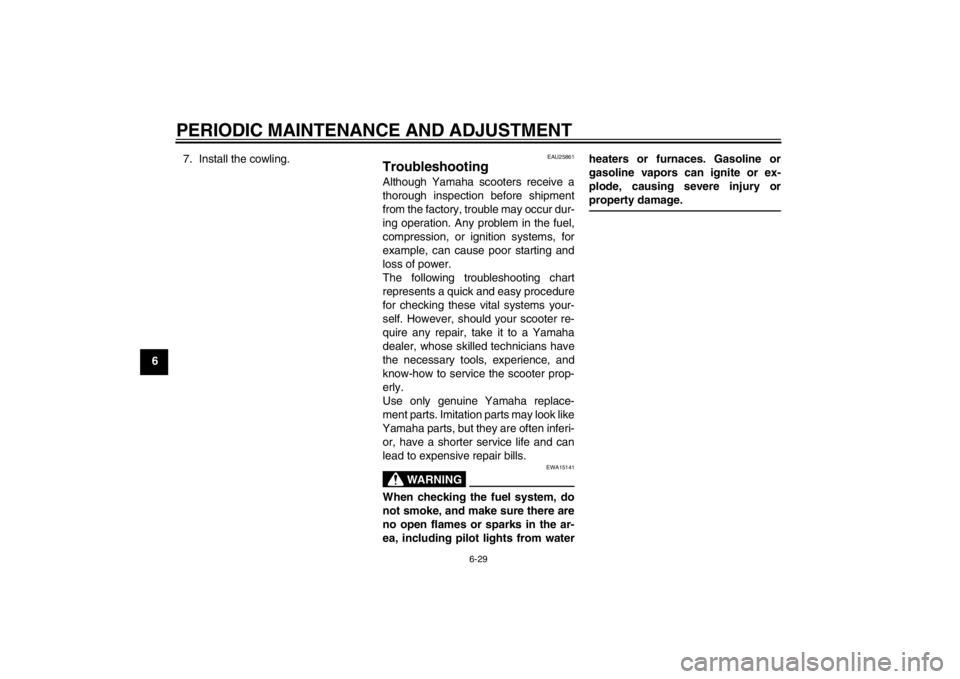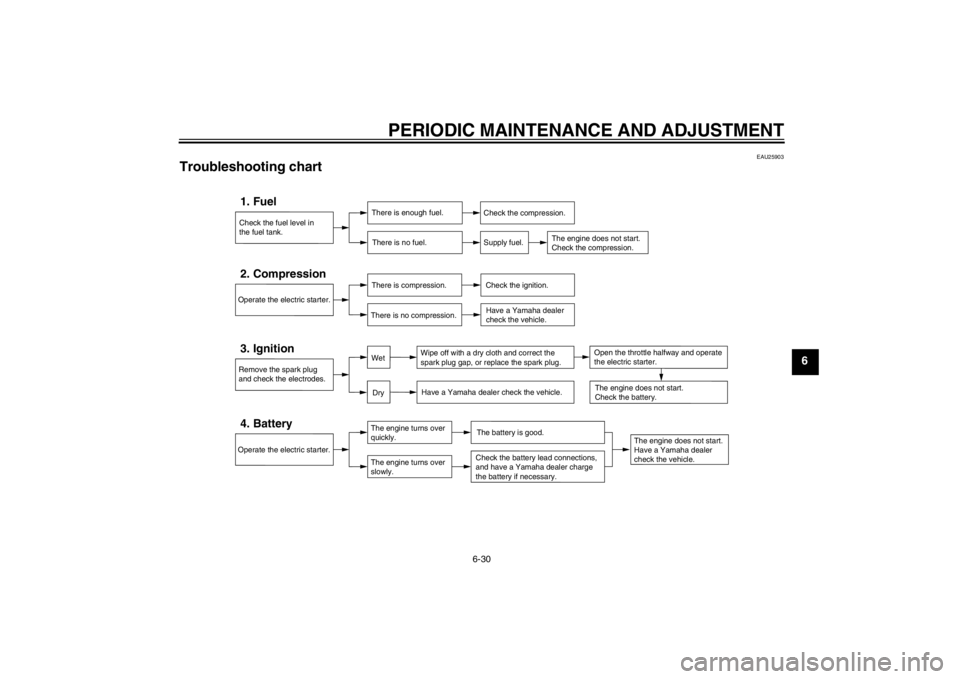ignition YAMAHA CYGNUS L 2012 Owners Manual
[x] Cancel search | Manufacturer: YAMAHA, Model Year: 2012, Model line: CYGNUS L, Model: YAMAHA CYGNUS L 2012Pages: 76, PDF Size: 1.56 MB
Page 6 of 76

TABLE OF CONTENTSSAFETY INFORMATION ..................1-1
Further safe-riding points ................1-5
DESCRIPTION ..................................2-1
Left view ..........................................2-1
Right view ........................................2-2
Controls and instruments.................2-3
INSTRUMENT AND CONTROL
FUNCTIONS.......................................3-1
Main switch/steering lock ................3-1
Keyhole cover .................................3-2
Indicator lights and warning light ....3-2
Speedometer unit ...........................3-3
Self-diagnosis device ......................3-3
Fuel gauge ......................................3-4
Handlebar switches ........................3-4
Front brake lever ............................3-5
Rear brake lever .............................3-5
Fuel tank cap ..................................3-5
Fuel .................................................3-6
Catalytic converters ........................3-7
Kickstarter .......................................3-8
Seat ................................................3-8
Helmet holders ...............................3-9
Storage compartments ...................3-9
Carrier ...........................................3-11
Luggage hook ...............................3-11
Grab bar .......................................3-11
Sidestand ......................................3-12
Ignition circuit cut-off system ........3-12FOR YOUR SAFETY –
PRE-OPERATION CHECKS............. 4-1
OPERATION AND IMPORTANT
RIDING POINTS................................. 5-1
Starting the engine ......................... 5-1
Starting off ...................................... 5-2
Acceleration and deceleration ........ 5-2
Braking ........................................... 5-2
Tips for reducing fuel
consumption ............................... 5-3
Engine break-in .............................. 5-3
Parking ........................................... 5-4
PERIODIC MAINTENANCE AND
ADJUSTMENT................................... 6-1
Periodic maintenance chart for
the emission control system ....... 6-3
General maintenance and
lubrication chart .......................... 6-4
Removing and installing cowlings
and panels .................................. 6-7
Checking the spark plug ................. 6-9
Engine oil ..................................... 6-10
Final transmission oil .................... 6-12
Air filter and V-belt case air filter
elements ................................... 6-13
Checking the engine idling
speed ........................................ 6-15
Checking the throttle grip free
play ........................................... 6-15Valve clearance ........................... 6-15
Tires ............................................. 6-16
Cast wheels ................................. 6-17
Checking the front brake lever
free play .................................... 6-18
Adjusting the rear brake lever
free play .................................... 6-18
Checking the front brake pads
and rear brake shoes ............... 6-19
Checking the brake fluid level ...... 6-20
Changing the brake fluid .............. 6-21
Checking and lubricating
the cables ................................. 6-21
Checking and lubricating
the throttle grip and cable ......... 6-21
Lubricating the front and
rear brake levers ...................... 6-22
Checking and lubricating the
centerstand and sidestand ....... 6-22
Checking the front fork ................. 6-23
Checking the steering .................. 6-24
Checking the wheel bearings ....... 6-24
Battery ......................................... 6-24
Replacing the fuse ....................... 6-26
Replacing the headlight bulb ....... 6-26
Replacing a front turn signal
light bulb ................................... 6-27
Rear turn signal light and
tail/brake light ........................... 6-28
Replacing the auxiliary light
bulb ........................................... 6-28U1RSE0E0.book Page 1 Tuesday, October 18, 2011 8:56 AM
Page 17 of 76

INSTRUMENT AND CONTROL FUNCTIONS
3-1
3
EAU45440
Main switch/steering lock The main switch/steering lock controls
the ignition and lighting systems, and is
used to lock the steering. The various
positions are described below.TIPThe main switch/steering lock is
equipped with a keyhole cover. (See
page 3-2.)
EAU10650
ON
All electrical systems are supplied with
power, the headlight, meter lighting,
taillight and auxiliary light come on, and
the engine can be started. The key can-
not be removed.
EAU10661
OFF
All electrical systems are off. The key
can be removed.
WARNING
EWA10061
Never turn the key to “OFF” or
“LOCK” while the vehicle is moving.
Otherwise the electrical systems will
be switched off, which may result in
loss of control or an accident.
EAU49001
LOCK
The steering and the centerstand are
locked, and all electrical systems are
off. The key can be removed.To lock the steering and the center-
stand1. Put the scooter on the center-
stand.
2. Turn the handlebars all the way to
the left.
3. Push the key in from the “OFF” po-
sition, and then turn it to “LOCK”
while still pushing it.
4. Remove the key.TIPWhen the steering is locked, the center-
stand is locked, and the scooter cannot
be taken off it.
ON
OPEN
OPENPUSH
LOCKOFF
1. Push.
2. Turn.12
U1RSE0E0.book Page 1 Tuesday, October 18, 2011 8:56 AM
Page 22 of 76

INSTRUMENT AND CONTROL FUNCTIONS
3-6
3
WARNING
EWA11091
Make sure that the fuel tank cap is
properly closed after filling fuel.
Leaking fuel is a fire hazard.
EAU13221
Fuel Make sure there is sufficient gasoline in
the tank.
WARNING
EWA10881
Gasoline and gasoline vapors are
extremely flammable. To avoid fires
and explosions and to reduce the
risk of injury when refueling, follow
these instructions.1. Before refueling, turn off the en-
gine and be sure that no one is sit-
ting on the vehicle. Never refuel
while smoking, or while in the vi-
cinity of sparks, open flames, or
other sources of ignition such as
the pilot lights of water heaters and
clothes dryers.
2. Do not overfill the fuel tank. When
refueling, be sure to insert the
pump nozzle into the fuel tank filler
hole. Stop filling when the fuel
reaches the bottom of the filler
tube. Because fuel expands when
it heats up, heat from the engine or
the sun can cause fuel to spill out
of the fuel tank.3. Wipe up any spilled fuel immedi-
ately. NOTICE: Immediately wipe
off spilled fuel with a clean, dry,
soft cloth, since fuel may deteri-
orate painted surfaces or plastic
parts.
[ECA10071]
4. Be sure to securely close the fuel
tank cap.
WARNING
EWA15151
Gasoline is poisonous and can
cause injury or death. Handle gaso-
line with care. Never siphon gaso-
line by mouth. If you should swallow
some gasoline or inhale a lot of gas-
oline vapor, or get some gasoline in
your eyes, see your doctor immedi-1. Fuel tank filler tube
2. Maximum fuel level
2 1
U1RSE0E0.book Page 6 Tuesday, October 18, 2011 8:56 AM
Page 28 of 76

INSTRUMENT AND CONTROL FUNCTIONS
3-12
3
EAU15305
Sidestand The sidestand is located on the left side
of the frame. Raise the sidestand or
lower it with your foot while holding the
vehicle upright.TIPThe built-in sidestand switch is part of
the ignition circuit cut-off system, which
cuts the ignition in certain situations.
(See the following section for an expla-
nation of the ignition circuit cut-off sys-
tem.)
WARNING
EWA10241
The vehicle must not be ridden with
the sidestand down, or if the side-
stand cannot be properly moved up
(or does not stay up), otherwise the
sidestand could contact the ground
and distract the operator, resulting
in a possible loss of control.
Yamaha’s ignition circuit cut-off
system has been designed to assist
the operator in fulfilling the respon-
sibility of raising the sidestand be-
fore starting off. Therefore, check
this system regularly and have a
Yamaha dealer repair it if it does not
function properly.
EAU15373
Ignition circuit cut-off system The ignition circuit cut-off system (com-
prising the sidestand switch and brake
light switches) has the following func-
tions.●
It prevents starting when the side-
stand is up, but neither brake is ap-
plied.
●
It prevents starting when either
brake is applied, but the sidestand
is still down.
●
It cuts the running engine when the
sidestand is moved down.
Periodically check the operation of the
ignition circuit cut-off system according
to the following procedure.
TIPThis check is most reliable if performed
with a warmed-up engine.
1. Sidestand
1
U1RSE0E0.book Page 12 Tuesday, October 18, 2011 8:56 AM
Page 31 of 76

FOR YOUR SAFETY – PRE-OPERATION CHECKS
4-2
4
Throttle grip Make sure that operation is smooth.
Check throttle grip free play.
If necessary, have Yamaha dealer adjust throttle grip free play and lubricate cable
and grip housing.6-15, 6-21
Control cables Make sure that operation is smooth.
Lubricate if necessary.6-21
Wheels and tires Check for damage.
Check tire condition and tread depth.
Check air pressure.
Correct if necessary.6-16, 6-17
Brake levers Make sure that operation is smooth.
Lubricate lever pivoting points if necessary.6-22
Centerstand, sidestand Make sure that operation is smooth.
Lubricate pivots if necessary.6-22
Chassis fasteners Make sure that all nuts, bolts and screws are properly tightened.
Tighten if necessary.—
Instruments, lights, signals
and switches Check operation.
Correct if necessary.—
Sidestand switch Check operation of ignition circuit cut-off system.
If system is not working correctly, have Yamaha dealer check vehicle.3-12 ITEM CHECKS PAGE
U1RSE0E0.book Page 2 Tuesday, October 18, 2011 8:56 AM
Page 32 of 76

OPERATION AND IMPORTANT RIDING POINTS
5-1
5
EAU15951
Read the Owner’s Manual carefully to
become familiar with all controls. If
there is a control or function you do not
understand, ask your Yamaha dealer.
WARNING
EWA10271
Failure to familiarize yourself with
the controls can lead to loss of con-
trol, which could cause an accident
or injury.
EAUT1865
Starting the engine NOTICE
ECA10250
See page 5-3 for engine break-in in-
structions prior to operating the ve-
hicle for the first time.In order for the ignition circuit cut-off
system to enable starting, the side-
stand must be up.
See page 3-12 for more information.
1. Turn the key to “ON”.
The engine trouble warning light
should come on for a few seconds,
then go off. NOTICE: If the warn-
ing light does not go off, have a
Yamaha dealer check its electri-
cal circuit.
[ECAT1120]
2. Close the throttle completely.
3. Start the engine by pushing the
start switch while applying the front
or rear brake.
If the engine does not start, re-
lease the start switch, wait a few
seconds, and then try again. Each
starting attempt should be as short
as possible to preserve the bat-
tery. Do not crank the engine more
than 5 seconds on any one at-tempt. If the engine does not start
with the starter motor, try using the
kickstarter.
NOTICE
ECA11042
For maximum engine life, never ac-
celerate hard when the engine is
cold!
U1RSE0E0.book Page 1 Tuesday, October 18, 2011 8:56 AM
Page 64 of 76

PERIODIC MAINTENANCE AND ADJUSTMENT
6-29
67. Install the cowling.
EAU25861
Troubleshooting Although Yamaha scooters receive a
thorough inspection before shipment
from the factory, trouble may occur dur-
ing operation. Any problem in the fuel,
compression, or ignition systems, for
example, can cause poor starting and
loss of power.
The following troubleshooting chart
represents a quick and easy procedure
for checking these vital systems your-
self. However, should your scooter re-
quire any repair, take it to a Yamaha
dealer, whose skilled technicians have
the necessary tools, experience, and
know-how to service the scooter prop-
erly.
Use only genuine Yamaha replace-
ment parts. Imitation parts may look like
Yamaha parts, but they are often inferi-
or, have a shorter service life and can
lead to expensive repair bills.
WARNING
EWA15141
When checking the fuel system, do
not smoke, and make sure there are
no open flames or sparks in the ar-
ea, including pilot lights from waterheaters or furnaces. Gasoline or
gasoline vapors can ignite or ex-
plode, causing severe injury or
property damage.
U1RSE0E0.book Page 29 Tuesday, October 18, 2011 8:56 AM
Page 65 of 76

PERIODIC MAINTENANCE AND ADJUSTMENT
6-30
6
EAU25903
Troubleshooting chart
Check the fuel level in
the fuel tank.1. Fuel
There is enough fuel.
There is no fuel.
Check the compression.
Supply fuel.
The engine does not start.
Check the compression.
Operate the electric starter.2. Compression
There is compression.
There is no compression.
Check the ignition.
Have a Yamaha dealer
check the vehicle.
Remove the spark plug
and check the electrodes.3. Ignition
Wipe off with a dry cloth and correct the
spark plug gap, or replace the spark plug.
Have a Yamaha dealer check the vehicle.
The engine does not start.
Have a Yamaha dealer
check the vehicle.
The engine does not start.
Check the battery.
Operate the electric starter.4. Battery
The engine turns over
quickly.
The engine turns over
slowly.
The battery is good.Check the battery lead connections,
and have a Yamaha dealer charge
the battery if necessary.
DryWet
Open the throttle halfway and operate
the electric starter.
U1RSE0E0.book Page 30 Tuesday, October 18, 2011 8:56 AM
Page 71 of 76

SPECIFICATIONS
8-2
8
Front tire:Type:
Tubeless
Size:
100/90-10 56J
Manufacturer/model:
CHENG SHIN/C-922-XRear tire:Type:
Tubeless
Size:
100/90-10 56J
Manufacturer/model:
CHENG SHIN/C-940-XLoading:Maximum load:
165 kg (364 lb)
(Total weight of rider, passenger, cargo and
accessories)Tire air pressure (measured on cold
tires):Loading condition:
0–75 kg (0–165 lb)
Front:
175 kPa (1.75 kgf/cm², 25 psi)
Rear:
250 kPa (2.50 kgf/cm², 36 psi)
Loading condition:
75–153 kg (165–337 lb)
Front:
175 kPa (1.75 kgf/cm², 25 psi)
Rear:
250 kPa (2.50 kgf/cm², 36 psi)
Front wheel:Wheel type:
Cast wheel
Rim size:
J10 x MT2.15Rear wheel:Wheel type:
Cast wheel
Rim size:
J10 x MT2.50Front brake:Type:
Single disc brake
Operation:
Right hand operation
Specified brake fluid:
DOT 3 or 4Rear brake:Type:
Drum brake
Operation:
Left hand operationFront suspension:Type:
Telescopic fork
Spring/shock absorber type:
Coil spring/oil damper
Wheel travel:
80.0 mm (3.15 in)Rear suspension:Type:
Unit swing
Spring/shock absorber type:
Coil spring/oil damperWheel travel:
63.0 mm (2.48 in)
Electrical system:Ignition system:
DC CDI
Charging system:
AC magnetoBattery:Model:
YTX7A-BS
Voltage, capacity:
12 V, 6.0 AhHeadlight:Bulb type:
IncandescenceBulb voltage, wattage × quantity:Headlight:
12 V, 35 W/35 W × 1
Tail/brake light:
12 V, 5.0 W/21.0 W × 1
Front turn signal light:
12 V, 10.0 W × 2
Rear turn signal light:
12 V, 16.0 W × 2
Auxiliary light:
12 V, 3.0 W × 1
Meter lighting:
12 V, 3.4 W × 2
High beam indicator light:
12 V, 1.7 W × 1
Turn signal indicator light:
12 V, 1.7 W × 1
Engine trouble warning light:
12 V, 3.4 W × 1
U1RSE0E0.book Page 2 Tuesday, October 18, 2011 8:56 AM
Page 74 of 76

INDEXAAcceleration and deceleration................. 5-2
Air filter and V-belt case air filter
elements ............................................. 6-13
Auxiliary light bulb, replacing ................ 6-28BBattery................................................... 6-24
Brake fluid, changing ............................ 6-21
Brake fluid level, checking .................... 6-20
Brake lever, front..................................... 3-5
Brake lever, rear ..................................... 3-5
Brake levers, lubricating........................ 6-22
Brake pads and shoes, checking .......... 6-19
Braking .................................................... 5-2CCables, checking and lubricating .......... 6-21
Care ........................................................ 7-1
Carrier ................................................... 3-11
Catalytic converters ................................ 3-7
Centerstand and sidestand,
checking and lubricating ..................... 6-22
Cowlings and panels,
removing and installing ......................... 6-7DDimmer switch ........................................ 3-4EEngine break-in ....................................... 5-3
Engine idling speed, checking .............. 6-15
Engine oil .............................................. 6-10
Engine serial number .............................. 9-1
Engine trouble warning light.................... 3-3FFinal transmission oil ............................ 6-12
Frame serial number ............................... 9-1Front brake lever free play, checking ... 6-18
Front fork, checking .............................. 6-23
Fuel......................................................... 3-6
Fuel consumption, tips for reducing........ 5-3
Fuel gauge.............................................. 3-4
Fuel tank cap .......................................... 3-5
Fuse, replacing ..................................... 6-26
GGrab bar ............................................... 3-11HHandlebar switches ................................ 3-4
Headlight bulb, replacing ...................... 6-26
Helmet holders ....................................... 3-9
High beam indicator light ........................ 3-2
Horn switch ............................................. 3-4IIdentification numbers ............................ 9-1
Ignition circuit cut-off system ................ 3-12
Indicator lights and warning light ............ 3-2KKeyhole cover ......................................... 3-2
Kickstarter............................................... 3-8LLuggage hook ....................................... 3-11MMain switch/steering lock........................ 3-1
Maintenance and lubrication, periodic .... 6-4
Maintenance, emission control system... 6-3
Matte color, caution ................................ 7-1PParking ................................................... 5-4
Part locations .......................................... 2-1RRear brake lever free play, adjusting .... 6-18Rear turn signal light and
tail/brake light...................................... 6-28
SSafe-riding points .................................... 1-5
Safety information ................................... 1-1
Seat ......................................................... 3-8
Self-diagnosis device .............................. 3-3
Sidestand .............................................. 3-12
Spark plug, checking ............................... 6-9
Specifications .......................................... 8-1
Speedometer unit .................................... 3-3
Starting off ............................................... 5-2
Starting the engine .................................. 5-1
Start switch.............................................. 3-4
Steering, checking................................. 6-24
Storage.................................................... 7-3
Storage compartments ............................ 3-9TThrottle grip and cable,
checking and lubricating ..................... 6-21
Throttle grip free play, checking ............ 6-15
Tires ...................................................... 6-16
Troubleshooting .................................... 6-29
Troubleshooting chart ........................... 6-30
Turn signal indicator light ........................ 3-2
Turn signal light bulb (front),
replacing ............................................. 6-27
Turn signal switch ................................... 3-4VValve clearance..................................... 6-15WWheel bearings, checking ..................... 6-24
Wheels .................................................. 6-17
U1RSE0E0.book Page 1 Tuesday, October 18, 2011 8:56 AM